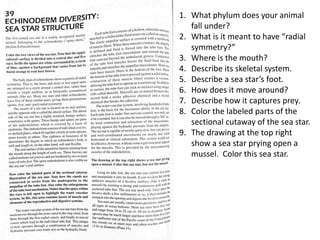
Marine Mammals Questions and Facts
- 1. 1. What phylum does your animal fall under? 2. What is it meant to have “radial symmetry?” 3. Where is the mouth? 4. Describe its skeletal system. 5. Describe a sea star’s foot. 6. How does it move around? 7. Describe how it captures prey. 8. Color the labeled parts of the sectional cutaway of the sea star. 9. The drawing at the top right show a sea star prying open a mussel. Color this sea star.
- 2. 1. Where can fish live? 2. At what speeds can a flying fish break the surface? 3. Where can find flying fish? 4. What do they feed off of? 5. What do herring feed off of? 6. Where can you find herring? 7. How many tons of herring is caught every year? 8. Where can you find swordfish? 9. Provide characteristics of a swordfish. 10.Describe how a swordfish swims. 11. Color your fish bases on the information in bold.
- 3. 1. Describe the pelagic zone. 2. Provide 3 facts about: a. coral grouper b. Thrumpetfish c. Golden boxfish d. Butterflyfish e. Moray eel. 3. Color each fish based from your reading.
- 4. 1. How many species of sharks exist? 2. Provide 3 facts for the following: a. Basking shark b. Hammerhead c. Great white d. Thresher 3. Color sharks based from the information provided in bold.
- 5. 1. Compare and contrast fish and reptiles. 2. Where does a green sea turtle live? 3. What does great sea turtle feed off of? 4. How can human influence kill turtles? 5. Describe how they nest. 6. How many eggs does a female lay? 7. Provide 5 facts about sea snakes. 8. Color the four illustrations of egg laying, hatching, and juviniles.
- 6. 1. What are the 2 groups of marine reptiles? 2. Provide 5 facts about: a. Iguana b. Crocodile 3. Color your animals based from your reading in bold.
- 7. 1. Describe a “mammal?” 2. Provide 5 facts about: a. Sea otter b. Sea lion c. Dugong d. dolphin 3. Color each mammal based from your reading.
- 8. 1. How many species of toothed whales exist? 2. Describe the process of echolocation? 3. Provide 5 facts about: a. Sperm whale b. Killer whale 3. Color each fish based from your reading.
